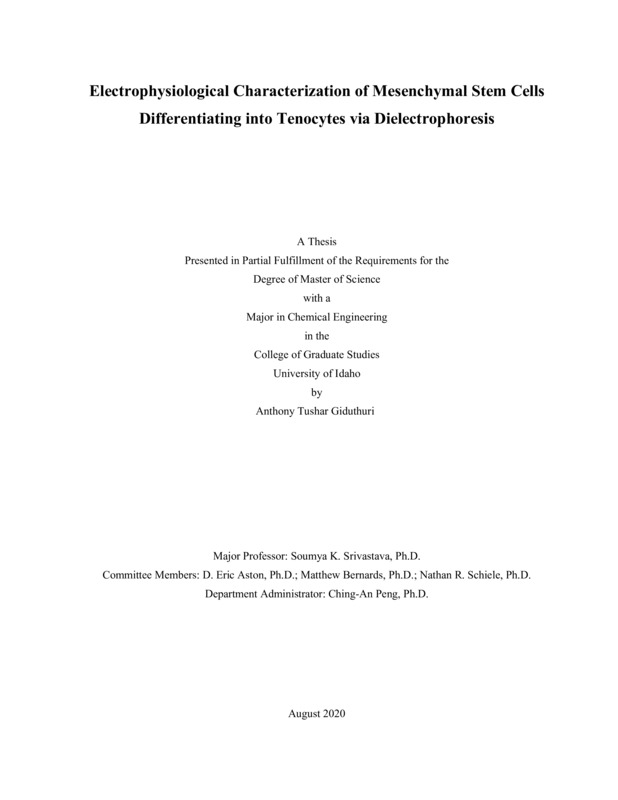Electrophysiological Characterization of Mesenchymal Stem Cells Differentiating into Tenocytes via Dielectrophoresis
Giduthuri, Anthony Tushar. (2020-08). Electrophysiological Characterization of Mesenchymal Stem Cells Differentiating into Tenocytes via Dielectrophoresis. Theses and Dissertations Collection, University of Idaho Library Digital Collections. https://www.lib.uidaho.edu/digital/etd/items/giduthuri_idaho_0089n_11941.html
- Title:
- Electrophysiological Characterization of Mesenchymal Stem Cells Differentiating into Tenocytes via Dielectrophoresis
- Author:
- Giduthuri, Anthony Tushar
- Date:
- 2020-08
- Keywords:
- characterization crossover frequency dielectrophoresis electrokinetics mesenchymal stem cells
- Program:
- Chemical and Materials Science Engineering
- Subject Category:
- Chemical engineering
- Abstract:
-
Tenocytes or tendon cells are the primary cells of a tendon that are responsible for holding a muscle and a bone, and are found throughout the body from head to the feet at several muscle bone joints such as collar bone, hip joint, knee, etc. It is also a major component of the musculoskeletal system. Tendons are susceptible to injuries such as tendinitis, tendon rupture etc., due to the effects of aging and stress. Stem cell based therapies offer alternative methods to treat such conditions. Among various types of stem cells, mesenchymal stem cells (MSCs), a type of multipotent stem cell, are known for their ability to regenerate and differentiate to tendon lineages. Undifferentiated MSCs derived from the bone marrow of a mouse, are characterized to obtain dielectric properties (i.e., conductivity and permittivity) of their outer membrane and cytoplasm using the dielectrophoretic crossover frequency technique. Undifferentiated MSCs are then treated with growth factors to induce differentiation (tenogenesis) into tenocytes and are dielectrically characterized at several time points. In this thesis, we chose to explore the day-3 time point of differentiation to detect changes in the membrane and cytoplasm along with undifferentiated cells aged to day-3 as control samples. Experimental results are statistically analyzed for their reproducibility and are modeled using a single shell model to quantify the dielectric properties.
It is observed that the electrical nature of the cells significantly varied through their course of differentiation, which will be utilized to serve as a label-free biomarker for sorting the differentiated MSCs from the undifferentiated ones. Sorted differentiated cells can then be used in stem cell based therapy without resulting in post-treatment complications such as tumors. The designed stem cell sorter via dielectrophoresis (DEP) in a label-free way avoids complications involved in the current separation techniques such as FACS and MACS.
- Description:
- masters, M.S., Chemical and Materials Science Engineering -- University of Idaho - College of Graduate Studies, 2020-08
- Major Professor:
- Srivastava, Soumya K
- Committee:
- Aston, Eric; Bernards, Matthew; Schiele, Nathan
- Defense Date:
- 2020-08
- Identifier:
- Giduthuri_idaho_0089N_11941
- Type:
- Text
- Format Original:
- Format:
- application/pdf
- Rights:
- In Copyright - Educational Use Permitted. For more information, please contact University of Idaho Library Special Collections and Archives Department at libspec@uidaho.edu.
- Standardized Rights:
- http://rightsstatements.org/vocab/InC-EDU/1.0/

